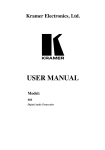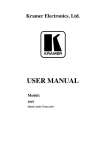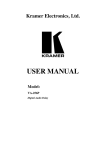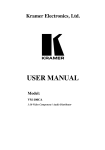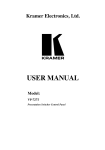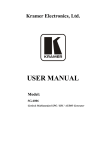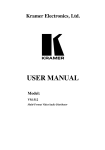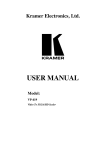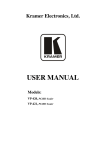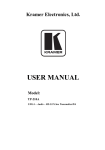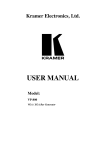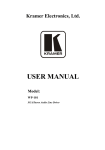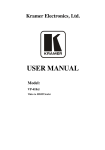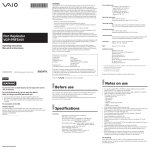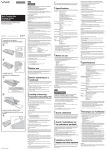Download USER MANUAL - AV-iQ
Transcript
Kramer Electronics, Ltd. USER MANUAL Model: 466 Digital Audio Transcoder Contents Contents 1 2 3 4 5 5.1 6 Introduction Getting Started Your Digital Audio Transcoder Using the Digital Audio Transcoder Cascading Machines Using Additional 466 Machines Technical Specifications 1 1 1 5 7 9 10 Figures Figure 1: 466 Digital Audio Transcoder Figure 2: 466 Digital Audio Transcoder Underside Mode Selection Switch Figure 3: Connecting the 466 Digital Audio Transcoder Figure 4: Extending the Range with the 466 Digital Audio Transcoder 3 4 6 8 Tables Table 1: Features and Functions of the Digital Audio Transcoder Table 2: 466 Underside Features Table 3: Technical Specifications of the Digital Audio Transcoder 3 4 10 i Introduction 1 Introduction Welcome to Kramer Electronics (since 1981): a world of unique, creative and affordable solutions to the infinite range of problems that confront the video, audio and presentation professional on a daily basis. In recent years, we have redesigned and upgraded most of our line, making the best even better! Our 350-plus different models now appear in 8 Groups1, which are clearly defined by function. Congratulations on purchasing your Kramer 466 Digital Audio Transcoder. This product is ideal for the following typical applications: Video production and duplication studios Audio recording studios Live broadcasting and editing The package includes the following items: 466 Digital Audio Transcoder Power adapter (12V DC Input) This user manual2 2 Getting Started We recommend that you: Unpack the equipment carefully and save the original box and packaging materials for possible future shipment Review the contents of this user manual 3 Your Digital Audio Transcoder The high performance 466 Digital Audio Transcoder is a converter with 4 inputs and 4 outputs as follows: Professional balanced 110 ohms AES/EBU on detachable terminal block connectors AES-ID3 75 on BNC connectors Consumer 75 ohms S/PDIF on RCA connectors Optical TosLink® in and out connectors 1 GROUP 1: Distribution Amplifiers; GROUP 2: Video and Audio Switchers, Matrix Switchers and Controllers; GROUP 3: Video, Audio, VGA/XGA Processors; GROUP 4: Interfaces and Sync Processors; GROUP 5: Twisted Pair Interfaces; GROUP 6: Accessories and Rack Adapters; GROUP 7: Scan Converters and Scalers; and GROUP 8: Cables and Connectors 2 Download up-to-date Kramer user manuals and software from our Web site at http://www.kramerelectronics.com 1 Your Digital Audio Transcoder Additionally: When an input is selected, all the outputs are available simultaneously All inputs and outputs are capable of receiving and transmitting 24 bit, 192kHz digital audio, including multi-channel audio A twisted pair input and 2 identical twisted pair outputs are also provided to support an extensive cascade of branching, providing multiple outputs over a long distance The system bit can be set to professional or consumer status, while all the other system bits remain the same The 466 Digital Audio Transcoder: Can transmit the highest quality digital audio over several hundred meters when several 466 units are used – one as a transmitter and one or more as receivers Has transformer coupled AES/EBU and AES-ID3 inputs and outputs Accepts all serial digital audio transmission standards, compliant with IEC 60958, S/PDIF, EIAJ CP1201 and AES3 interface standards, as well as multi-channel standards Is 12VDC fed and is housed in a DigiTOOLS enclosure To achieve the best performance: Connect only good quality connection cables, thus avoiding interference, deterioration in signal quality due to poor matching, and elevated noise levels (often associated with low quality cables) Avoid interference from neighboring electrical appliances that may adversely influence signal quality Position your Kramer 466 Digital Audio Transcoder away from moisture, excessive sunlight and dust Close the optical cable’s connectors (when not in use) to protect them against exposure to dirt and dust Figure 1 and Table 1 define the 466 Digital Audio Transcoder, Figure 2 and Table 2 define the underside features: 2 KRAMER: SIMPLE CREATIVE TECHNOLOGY Your Digital Audio Transcoder Figure 1: 466 Digital Audio Transcoder Table 1: Features and Functions of the Digital Audio Transcoder # 4 5 6 7 OUTPUTS 3 Feature 12V DC TWISTED PAIR2 1 2 AES-ID3 BNC Connector S/PDIF RCA Connector OPTICAL TosLink® Connector OUT2 Detachable Terminal Block OUT1 Detachable Terminal Block IN Detachable Terminal Block Function +12V DC connector for powering the unit Connect to the digital audio acceptor (75 ) Connect to the digital audio acceptor Connect to the digital audio acceptor1 Connect to an additional 466 receiver Connect to an additional 466 receiver Connect to the OUT1 or OUT2 detachable terminal block on another (transmitter) 466 unit, when using more than one 466 unit (transmitter/receivers) 1 Use an optical cable, such as Sony’s POC-15A (not included in the package) 2 When connecting a single machine, this section is not relevant 3 Your Digital Audio Transcoder # 9 10 11 12 13 LOCAL INPUT SELECTOR AES/ EBU 8 Feature OUT Detachable Terminal Block IN Detachable Terminal Block OPTICAL Button Function Connect to the digital audio acceptor Press to select the optical input source S/PDIF Button Press to select the S/PDIF source Connect to the digital audio source AES-ID3 Button Press to select the AES-ID3 source AES/EBU Button Press to select the AES/EBU source TWISTED PAIR / LOCAL Push Button 15 OPTICAL TosLink® Connector S/PDIF RCA Connector AES-ID3 BNC Connector ON LED LINK LED 16 17 18 19 INPUTS 14 Release the button, to the LOCAL position, if a single 1 unit is used, or the unit is to operate as a transmitter Push the button in, to the TWISTED PAIR position, if 1 the unit operates as a receiver 2 Connect to the digital audio source Connect to the digital audio source Connect to the digital audio source (75 ) Lights red when the system is powered Lights green when the input is connected and the signal is of good quality and can be decoded Figure 2: 466 Digital Audio Transcoder Underside Mode Selection Switch Table 2: 466 Underside Features # 1 Feature MODE SELECT Switch Function Slide up to set to PROF. (professional) or slide down to set to CONSUMER to change the system bit3 1 See Figure 4 2 Use an optical cable, such as Sony’s POC-15A (not included in the package) 3 For example, when connecting a consumer source (a DVD player) and outputting to a professional acceptor (a DAT recorder), it may be necessary to change the system bit status by altering the selected PROF./CONSUMER mode 4 KRAMER: SIMPLE CREATIVE TECHNOLOGY Using the Digital Audio Transcoder 4 Using the Digital Audio Transcoder To connect a single 466 Digital Audio Transcoder machine, as the example in Figure 3 illustrates1, do the following2: 1. Connect the sources as follows: Connect a digital audio source (for example, a DAT player) to the AES-ID3 INPUT BNC connector Connect a digital audio source (for example, a DVD player) to the S/PDIF INPUT RCA connector Connect a digital audio source (for example, a DVD player) to the OPTICAL INPUT TosLink® connector Connect an AES/EBU source (for example, a DAT player) to the AES/EBU detachable terminal block IN connector using a shielded twisted pair cable 2. Connect the acceptors as follows: Connect the OPTICAL OUTPUT TosLink® connector to a digital audio acceptor (for example, an AV receiver) Connect the S/PDIF OUTPUT RCA connector to a digital audio acceptor (for example, an AV receiver) Connect the AES-ID3 OUTPUT BNC connector to a digital audio acceptor (for example, a DAT recorder) Connect the AES/EBU detachable terminal block OUT connector (using a shielded twisted pair cable) to an AES/EBU acceptor (for example, a DAT recorder) 3. Connect the 12V DC power adapter to the power socket and connect the adapter to the mains electricity. 4. Release the TWISTED PAIR/LOCAL button to the LOCAL position. 5. Set the MODE SELECT switch button to PROF. or CONSUMER, as required (see Figure 2). 6. Press one of the LOCAL INPUT SELECTOR buttons to select an input source3. This source will appear on all outputs simultaneously. 1 You do not have to connect all inputs and outputs, connect only those that are required 2 Switch OFF the power on each device before connecting it to your 466. After connecting your 466, switch on its power and then switch on the power on each device 3 If the valid digital audio signal is present on the selected input, the green LINK LED will light 5 Using the Digital Audio Transcoder DVD Player DVD Player DAT Player DAT Player DAT Recorder DAT Recorder AV Receiver AV Receiver Figure 3: Connecting the 466 Digital Audio Transcoder 6 KRAMER: SIMPLE CREATIVE TECHNOLOGY Cascading Machines 5 Cascading Machines You can cascade several machines via the TWISTED PAIR detachable terminal blocks (OUT1, OUT2 and IN), to extend the range of the output signals over several hundred meters. To use several machines1, as illustrated in Figure 4, do the following2: 1. Connect the first 466 unit (the Transmitter3 in Figure 4) as described in section 4. 2. Connect Receiver4 # 1 (in Figure 4): Connect the outputs, as described in section 4 (numbered item 2) Push in the TWISTED PAIR/LOCAL button to the TWISTED PAIR position Connect the TWISTED PAIR OUT 1 detachable terminal block, on the Transmitter, to the TWISTED PAIR IN detachable terminal block on Receiver # 1, via a shielded twisted pair cable Set the MODE SELECT switch button to PROF. or CONSUMER, as required (see Figure 2) 3. Connect Receiver4 # 2 (in Figure 4): Connect the outputs, as described in section 4 (numbered item 2) Push in the TWISTED PAIR/LOCAL button to the TWISTED PAIR position Connect the TWISTED PAIR OUT 2 detachable terminal block, on the Transmitter, to the TWISTED PAIR IN detachable terminal block on Receiver # 2, via a shielded twisted pair cable Set the MODE SELECT switch button on each 466 unit to PROF. or CONSUMER, as required (see Figure 2) 4. Press one of the LOCAL INPUT SELECTOR buttons to select an input source5. This source will appear on all outputs simultaneously. If you wish to operate any of the connected units locally, connect the desired inputs to that unit and release the TWISTED PAIR/LOCAL button to the LOCAL position. 1 Switch OFF the power on each device before connecting it to your 466. After connecting your 466, switch on its power and then switch on the power on each device 2 You do not have to connect all inputs and outputs, connect only those that are required 3 This 466 unit is operating as a transmitter in this configuration 4 This 466 unit is operating as a receiver in this configuration 5 If the valid digital audio signal is present on the selected input, the green LINK LED will light 7 Cascading Machines To another 466 unit To another 466 unit Push in an input button to transmit to the outputs Figure 4: Extending the Range with the 466 Digital Audio Transcoder 8 KRAMER: SIMPLE CREATIVE TECHNOLOGY Cascading Machines 5.1 Using Additional 466 Machines You can connect additional 466 units (operating as receivers) to further extend the output signal range. To use additional 466 machines, do the following: 1. Connect the required outputs1 to the newly added 466 receiver unit. 2. Connect the TWISTED PAIR OUT 1 and/or OUT 2 detachable terminal blocks of the previously connected unit, to the TWISTED PAIR IN detachable terminal block on the newly added unit, using a shielded twisted pair cable. 3. Push in the TWISTED PAIR/LOCAL button on the new machine, to the TWISTED PAIR position2. 4. Set the MODE SELECT switch button on each 466 unit to PROF. or CONSUMER, as required (see Figure 2) 5. Press one of the LOCAL INPUT SELECTOR buttons to select an input source3. This source will appear on all outputs simultaneously When connecting several machines, push in the TWISTED PAIR/LOCAL button on all receiver units, except for the transmitter unit. 1 You do not have to connect all the outputs 2 Push in the TWISTED PAIR/LOCAL button on each unit except for the first machine (to which the inputs are connected). 3 If the valid digital audio signal is present on the selected input, the green LINK LED will light 9 Technical Specifications 6 Technical Specifications Table 3 includes the technical specifications: 1 Table 3: Technical Specifications of the Digital Audio Transcoder INPUTS: OUTPUTS: SAMPLING: STANDARDS: CONTROL: DIMENSIONS: POWER SOURCE: WEIGHT: ACCESSORIES: OPTIONS: 1 digital audio AES-ID3 on a BNC connector, 1 S/PDIF digital audio on an RCA connector, 1 TosLink® optical, 1 digital audio AES/EBU on a detachable terminal block, 1 twisted pair on a detachable terminal block 1 digital audio AES-ID3 on a BNC connector, 1 S/PDIF digital audio on an RCA connector, 1 TosLink® optical, 1 digital audio AES/EBU on a detachable terminal block, 2 twisted pairs on detachable terminal blocks 32, 44.1, 48, 96, 192 kHz sampling frequencies IEC 60958, S/PDIF, EIAJ CP1201 and AES3 interface standards, as well as multichannel standards Input select, local twisted-pair selector, system bit selector 12 cm x 7.5 cm x 2.5 cm (4.7" x 2.95" x 0.98", W, D, H) 12 VDC, 60 mA .25 kg (0.6 lbs.) approx. Power supply, mounting bracket RK-T1 or RK-T3 rack mount kit 1 Specifications are subject to change without notice 10 KRAMER: SIMPLE CREATIVE TECHNOLOGY LIMITED WARRANTY Kramer Electronics (hereafter Kramer) warrants this product free from defects in material and workmanship under the following terms. HOW LONG IS THE WARRANTY Labor and parts are warranted for three years from the date of the first customer purchase. WHO IS PROTECTED? Only the first purchase customer may enforce this warranty. WHAT IS COVERED AND WHAT IS NOT COVERED Except as below, this warranty covers all defects in material or workmanship in this product. The following are not covered by the warranty: 1. 2. 3. Any product which is not distributed by Kramer, or which is not purchased from an authorized Kramer dealer. If you are uncertain as to whether a dealer is authorized, please contact Kramer at one of the agents listed in the web site www.kramerelectronics.com. Any product, on which the serial number has been defaced, modified or removed. Damage, deterioration or malfunction resulting from: i) Accident, misuse, abuse, neglect, fire, water, lightning or other acts of nature ii) Product modification, or failure to follow instructions supplied with the product iii) Repair or attempted repair by anyone not authorized by Kramer iv) Any shipment of the product (claims must be presented to the carrier) v) Removal or installation of the product vi) Any other cause, which does not relate to a product defect vii) Cartons, equipment enclosures, cables or accessories used in conjunction with the product WHAT WE WILL PAY FOR AND WHAT WE WILL NOT PAY FOR We will pay labor and material expenses for covered items. We will not pay for the following: 1. 2. 3. Removal or installations charges. Costs of initial technical adjustments (set-up), including adjustment of user controls or programming. These costs are the responsibility of the Kramer dealer from whom the product was purchased. Shipping charges. HOW YOU CAN GET WARRANTY SERVICE 1. 2. 3. To obtain service on you product, you must take or ship it prepaid to any authorized Kramer service center. Whenever warranty service is required, the original dated invoice (or a copy) must be presented as proof of warranty coverage, and should be included in any shipment of the product. Please also include in any mailing a contact name, company, address, and a description of the problem(s). For the name of the nearest Kramer authorized service center, consult your authorized dealer. LIMITATION OF IMPLIED WARRANTIES All implied warranties, including warranties of merchantability and fitness for a particular purpose, are limited in duration to the length of this warranty. EXCLUSION OF DAMAGES The liability of Kramer for any effective products is limited to the repair or replacement of the product at our option. Kramer shall not be liable for: 1. 2. Damage to other property caused by defects in this product, damages based upon inconvenience, loss of use of the product, loss of time, commercial loss; or: Any other damages, whether incidental, consequential or otherwise. Some countries may not allow limitations on how long an implied warranty lasts and/or do not allow the exclusion or limitation of incidental or consequential damages, so the above limitations and exclusions may not apply to you. This warranty gives you specific legal rights, and you may also have other rights, which vary from place to place. NOTE: All products returned to Kramer for service must have prior approval. This may be obtained from your dealer. This equipment has been tested to determine compliance with the requirements of: EN-50081: "Electromagnetic compatibility (EMC); generic emission standard. Part 1: Residential, commercial and light industry" EN-50082: "Electromagnetic compatibility (EMC) generic immunity standard. Part 1: Residential, commercial and light industry environment". CFR-47: FCC Rules and Regulations: Part 15: “Radio frequency devices Subpart B – Unintentional radiators” CAUTION! Servicing the machines can only be done by an authorized Kramer technician. Any user who makes changes or modifications to the unit without the expressed approval of the manufacturer will void user authority to operate the equipment. Use the supplied DC power supply to feed power to the machine. Please use recommended interconnection cables to connect the machine to other components. 11 For the latest information on our products and a list of Kramer distributors, visit our Web site: www.kramerelectronics.com, where updates to this user manual may be found. We welcome your questions, comments and feedback. Kramer Electronics, Ltd. Web site: www.kramerelectronics.com E-mail: [email protected] P/N: 2900-000070 REV 1














